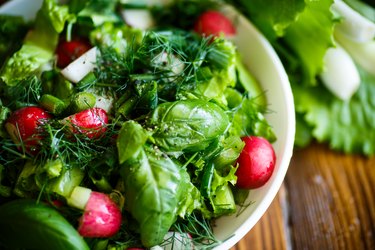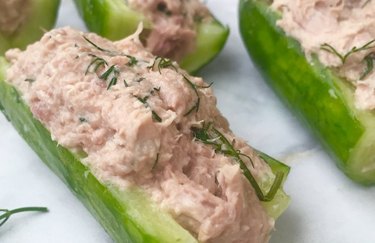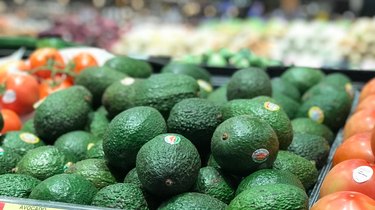
When you have a significant amount of weight to drop, it can feel impossible to get started. How do you go about losing 100 pounds or more? And, just as importantly, how will you keep it off?
Personal trainer Jeff Logan, CPT, says triple-digit weight loss is like shedding an entire person — and the process shouldn't be rushed. A safe, healthy rate of weight loss for someone who is 100 pounds or more overweight is between 1 to 3 pounds a week, he says. Using that math, it will take about a year to meet your goal.
Video of the Day
Video of the Day
But how? Here, Logan and other experts in nutrition and fitness share their best advice on realistically — and safely! — saying adios to 100-plus pounds for good.
1. Do Fill Half Your Plate With Non-Starchy Veggies

Though exercise is definitely part of the process, Carla Dueñas, RD, a dietitian with Baptist Health South Florida tells LIVESTRONG.com that, more than anything else, what we eat makes the biggest difference on the scale. Of all the dietary changes you should make when beginning your journey to better health, she says upping your intake of non-starchy veggies is the most vital.
"More vegetables means more vitamins and minerals, which are typically underrated as a source of energy. All that extra energy translates into better workouts and more calories burned," she explains.
Plus, veggies are overflowing with fiber. "Fiber keeps us full for a longer time because it's harder for our digestive system to break down, so we can last three to four hours feeling satisfied until the next meal or snack,"Dueñas explains.
Eat More of These Non-Starchy Vegetables
- Artichoke and artichoke hearts
- Asparagus
- Baby corn
- Bamboo shoots
- Beans (green, wax, Italian)
- Bean sprouts
- Beets
- Brussels sprouts
- Broccoli
- Cabbage (green, bok choy, Chinese)
- Carrots
- Cauliflower
- Celery
- Cucumber
- Eggplant
- Greens (collard, kale, mustard, turnip)
- Hearts of palm
- Jicama
- Kohlrabi
- Mushrooms
- Okra
- Onions
- Pea pods
- Peppers
- Radishes
- Rutabaga
- Salad greens (chicory, endive, escarole, lettuce, romaine, spinach, arugula, radicchio, watercress)
- Sprouts
- Squash (cushaw, summer, crookneck, spaghetti, zucchini)
- Sugar snap peas
- Swiss chard
- Tomato
- Turnips
- Water chestnuts
2. Don’t Get Fooled by Crash Diets
You can think of a "crash diet" the same way you would a clickbait post on Facebook. The headline is jarring and irresistible — but most of the time, the content is lackluster at best.
Any sort of eating plan that promises to help you lose weight super-fast without much effort isn't worth your time, says Audrey Heist, RD, dietitian and director of health engagement at AtlantiCare. She says many people are lured in by chicken-broth cleanses, detoxes and other seemingly simple ways to drop weight, but most of the time, these eating habits are only effective in the beginning, and they're actually harmful in the long run.
"Drastically changing our lifestyle habits all at once sets us up to fail," she says. "We often cannot and do not stick with the changes we've made, which leads to weight regain."
It's also important to note, according to Heist, that the quick weight loss caused by crash dieting can lead to muscle loss, which may also cause weight gain, since muscle helps keep our metabolism burning at a good clip.
Learn how to spot a crash diet along with three other types of unhealthy gimmicks to avoid if long-term weight loss is your goal.
3. Do Increase Protein Intake Throughout the Day

For many people, saying "no" to sweet treats and comfort foods is half the battle of staying on a healthy eating plan. But why do we find ourselves drooling over that doughnut at 3 p.m.? Probably because we didn't get enough protein at lunch, Dueñas says.
As she explains, increasing our protein intake will give us the defense we need to control hunger, thus making it easier to stay the course. "Adding a protein-packed afternoon snack is a great way to keep those cravings away," she says.
Some ideas:
- A protein shake made with your favorite protein powder (look for no added sugars)
- Greek yogurt with nuts and berries (opt for non-fat, plain Greek yogurt)
- Tuna cucumber boats (swap the mayo for mustard to reduce fat and calories)
Additionally, protein also plays a part in building and maintaining muscle mass from exercise. "When we lose weight fast, fat along with muscle are lost. We want to avoid this by constantly supplying the body with protein foods," Dueñas says.
Tip
If you're actively losing weight, aim to eat about 1.3 grams of lean protein per kilogram of body weight each day. Keep in mind that a kilogram equals about 2.2 pounds. So, for example, a 250-pound person should aim to eat about 148 grams of protein daily (for reference, a 3-ounce serving of roasted chicken breast contains about 25 grams of protein, per the USDA).
Read more: 15 Low-Calorie, High-Protein Foods for Weight Loss
4. Do Try Fasting Intermittently
Once you have a few months of clean eating under your belt, dietitian Brigid Titgemeier, RDN, LD, suggests implementing an intermittent fasting regimen into your lifestyle. There are several different methods, but the most popular involve fasting for 12 to 16 hours each day (including the time you're asleep) and eating your three meals within the remaining hours.
Although research is still somewhat limited on this eating plan, a December 2019 review in The New England Journal of Medicine found that intermittent fasting is effective for weight loss. Though whether it's because IF restricts late-night eating, decreases appetite or works in another way isn't totally clear yet.
To begin, try cutting off food from 8 p.m. to 8 a.m. — so you only eat your dinner and then breakfast, with no nibbles in between. As you feel more comfortable and your body adjusts, you can increase this fasting time by an hour every week until you reach 16.
The Beginner's Guide to 16:8 Fasting for Weight Loss
Get more details on the benefits of intermittent fasting and get four expert tips on how to start a 16:8 diet.
5. Don’t Severely Restrict Your Calories

If the way we lose weight is by consuming fewer calories than what we burn, then restricting our intake makes sense, right?
Well, yes, but only to a point, says Dueñas, who notes that severely restricting calories — to less than between 1,200 and 1,500 — actually causes our bodies to hold onto fat (since it's a valuable energy reserve) and break down muscle. This slows down metabolism and will leave you feeling hungry, exhausted and more susceptible to colds and flus, since your immune system is compromised, she adds.
Tip
According to the experts, the "magic number" of calories to trim from your daily diet is between 500 and 750. Since a pound of fat equals 3,500 calories, that deficit should lead to between 1 and 1.5 pounds of weight loss each week.
Overall, a good way to approach your calories, Titgemeier says, is to remember that balance is the key to long-term success. "It's important to think about nourishing the body rather than depriving it. Nourish your body with whole, unprocessed foods and try to avoid extreme measures of caloric restriction that are not sustainable," she urges.
6. Do Make Exercise a Priority
Adam Phillips, a NASM-certified personal trainer, hears it all the time: "I don't have time to focus on losing weight." Even though many of his potential clients walk in desperate to drop weight, they fail to actually budget the minutes and hours necessary to see success.
To encourage them to think differently, he reminds them just how many moments there are to dedicate to your health if you make it a priority: "There are 168 hours in a given week. Work and sleep take up 112 of those, but that leaves 56 hours in a week," he says. "Working out should not take any more than an hour each day. So, working out five days a week leaves you 51 hours to catch up on everything else."
According to the Physical Activity Guidelines for Americans, you should devote about half of those five weekly hours to moderate-intensity cardio (think: brisk walking or jogging) and half to muscle-strengthening activities that involve all your major muscle groups.
Discover Your Ultimate Weight-Loss Workout Plan
Learn how to choose the best exercises for weight loss and maximize their benefits.
7. Don’t Eat 'Low-Fat' Processed Foods

Take a stroll down your local grocery store and you'll be bombarded by one snack after another that advertises with "low-fat," "fat-free" and other diet-minded slogans. It's tempting, sure, since they seem healthy at first glance — but Titgemeier says they offer very little nutritional benefit.
How come? Fat doesn't make you fat, and we need some of it to keep our bodies running — and burning calories! — effectively. "Fat is important for increasing levels of fullness, improving brain health and decreasing inflammation," she says. "Just because you are trying to lose weight does not mean that you should start eating low-fat processed foods that remove fat through processing and then replace it with sugar or carbohydrates."
What are some healthy fats to look for instead? Titgemeier recommends whole-food options like avocado, chia seeds, ground flax seeds and olives, to name a few. Fatty fish like tuna and salmon are also good choices.
8. Do Limit All Added Sugars — Including Natural and Artificial Sources
Whether you realize it or not, sugar is in just about everything. Just think of all the places your tastebuds are engaged: cane, maple, honey and fruit syrups, nearly all packaged foods and even tomato sauces or other unlikely buys.
Here's the deal: If we don't limit the sugar we're eating (or drinking!), then we'll keep craving it, time and time again. "Our taste buds get used to it, as well as our brains, and we start needing more, very much like a drug," Dueñas says. And although artificial sweeteners don't pack in calories or spike blood sugar in the same way as natural sugars, they trigger the same reaction in the brain that makes us crave more sweets.
Whenever you can, limit all foods that have added natural or artificial sugar. It's best to eat what mother nature intended, straight from the ground or the farm, Dueñas says.
5 Easy Ways to Cut Down on Sugar
From smarter meal prepping to strategic shopping, check out five expert-approved tips to reduce the amount of added sugar in your diet.
9. Don’t Try to Do It Alone
When you are this close to grabbing a slice of pizza, or when you had a stressful day and that ice cream in the freezer is looking oh-so-appealing, it's important to have a compatibility buddy who is there to help you resist. Heist says it's incredibly beneficial to find someone — whether in person or virtually — who is also on a weight-loss journey, so you can lean on one another.
Keep in mind that you may need to look outside your circle of family and friends. While supportive, they may not understand the hurdles you face day-in and day-out with changing your lifestyle.
Heist says having a compatibility partner will keep you focused and give you the cognitive stamina required to lose significant weight. After all, the battle isn't just physical — it's mental, too.
"In today's environment, where we are exposed to high-calorie, processed foods, it can be easy to make unhealthy choices. Weight loss takes a commitment and a plan — it's not willpower so much as skillpower," she says.
If you're struggling to find a buddy, consider researching weight-loss groups on Facebook — like the LIVESTRONG.com Challenge Group — or looking into the community at your nearby gym. Chances are good that you'll soon stumble across someone who is eying the same 100-pound weight loss goal.
- American Diabetes Association: "Non-starchy Vegetables"
- USDA: "Chicken & Turkey Nutrition Facts"
- Office of Disease Prevention and Health Promotion: "Physical Activity Guidelines for Americans, 2nd Edition"
- The New England Journal of Medicine: "Effects of Intermittent Fasting on Health, Aging, and Disease"
Was this article helpful?
150 Characters Max
0/150
Thank you for sharing!
Thank you for your feedback!